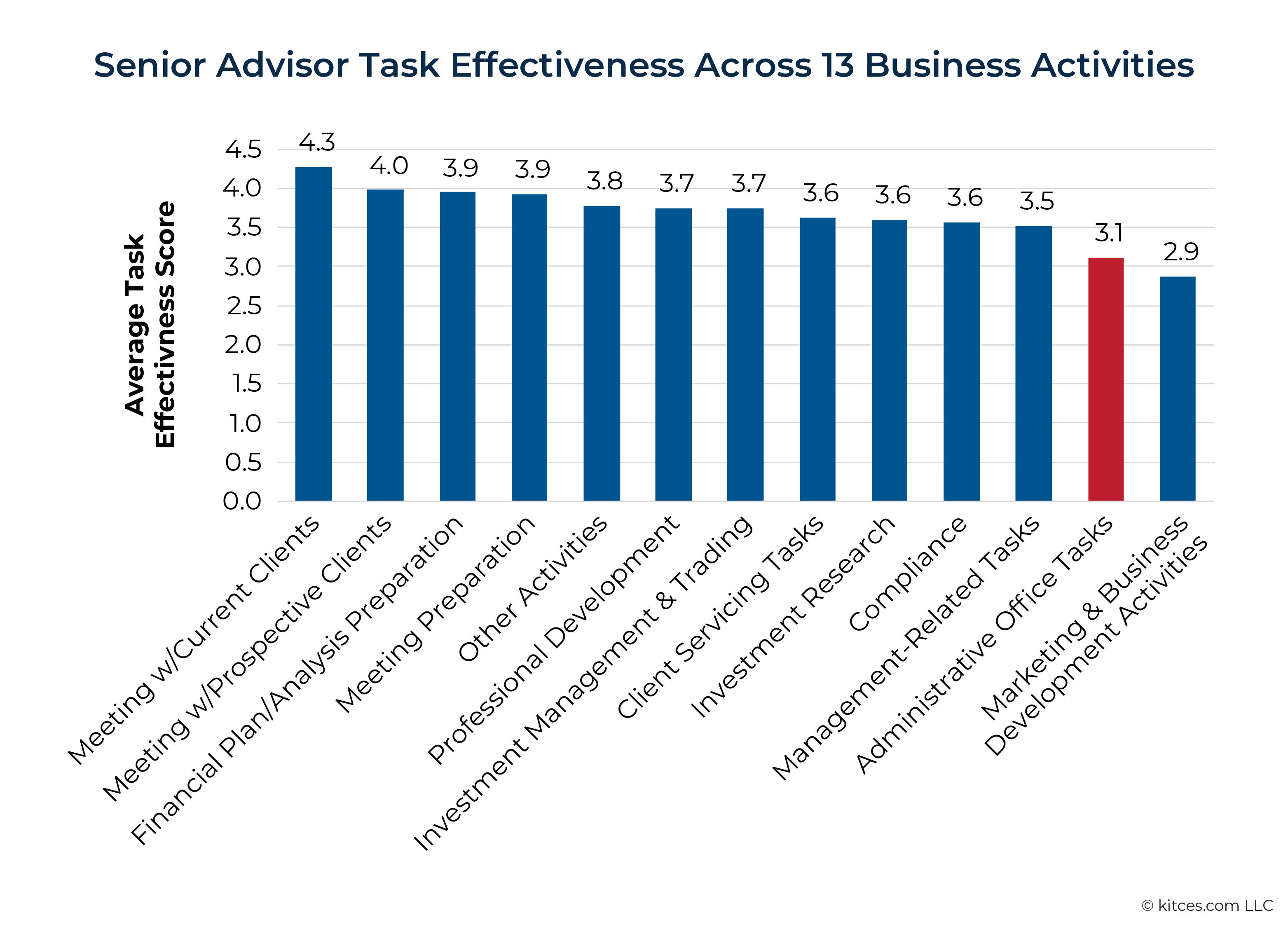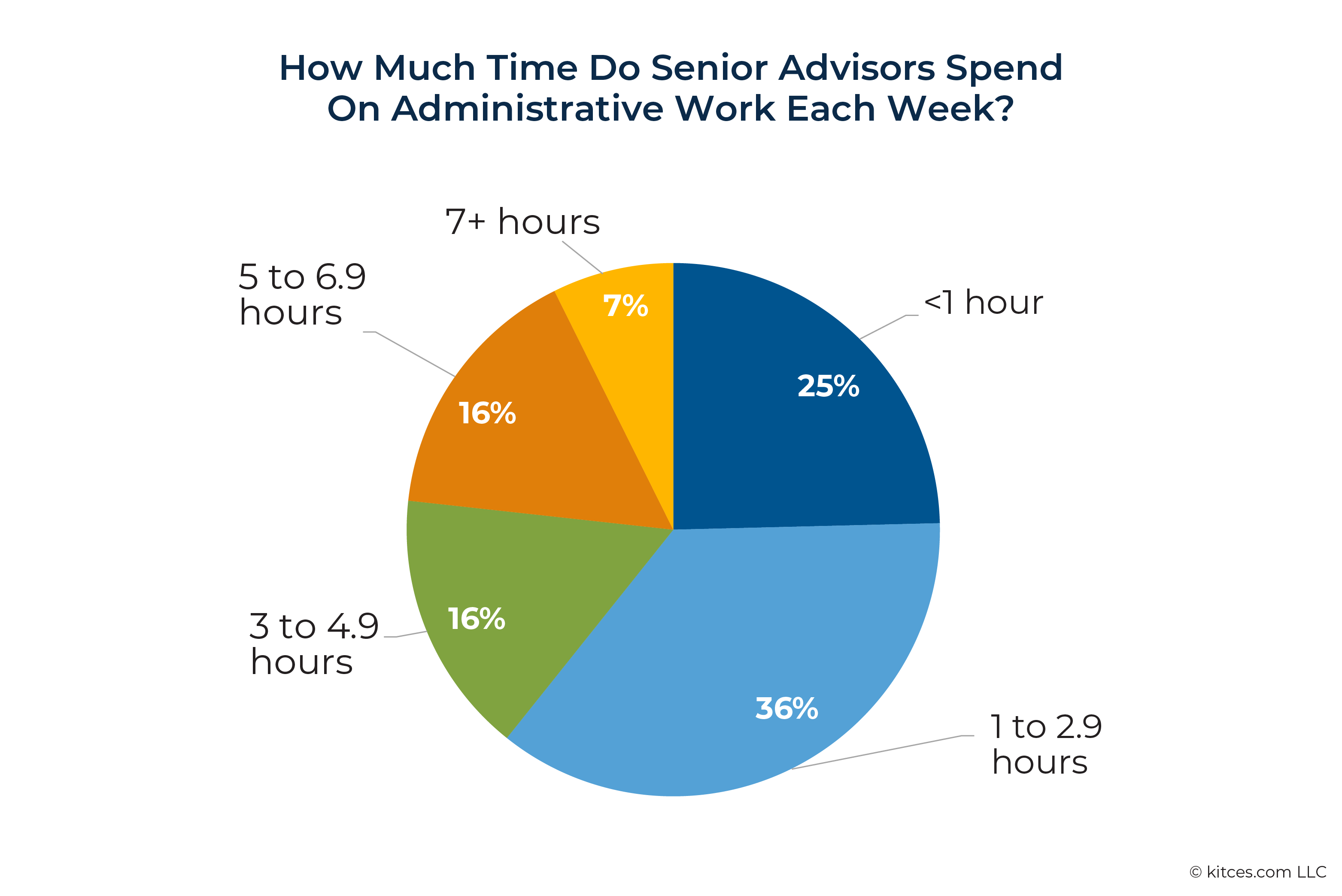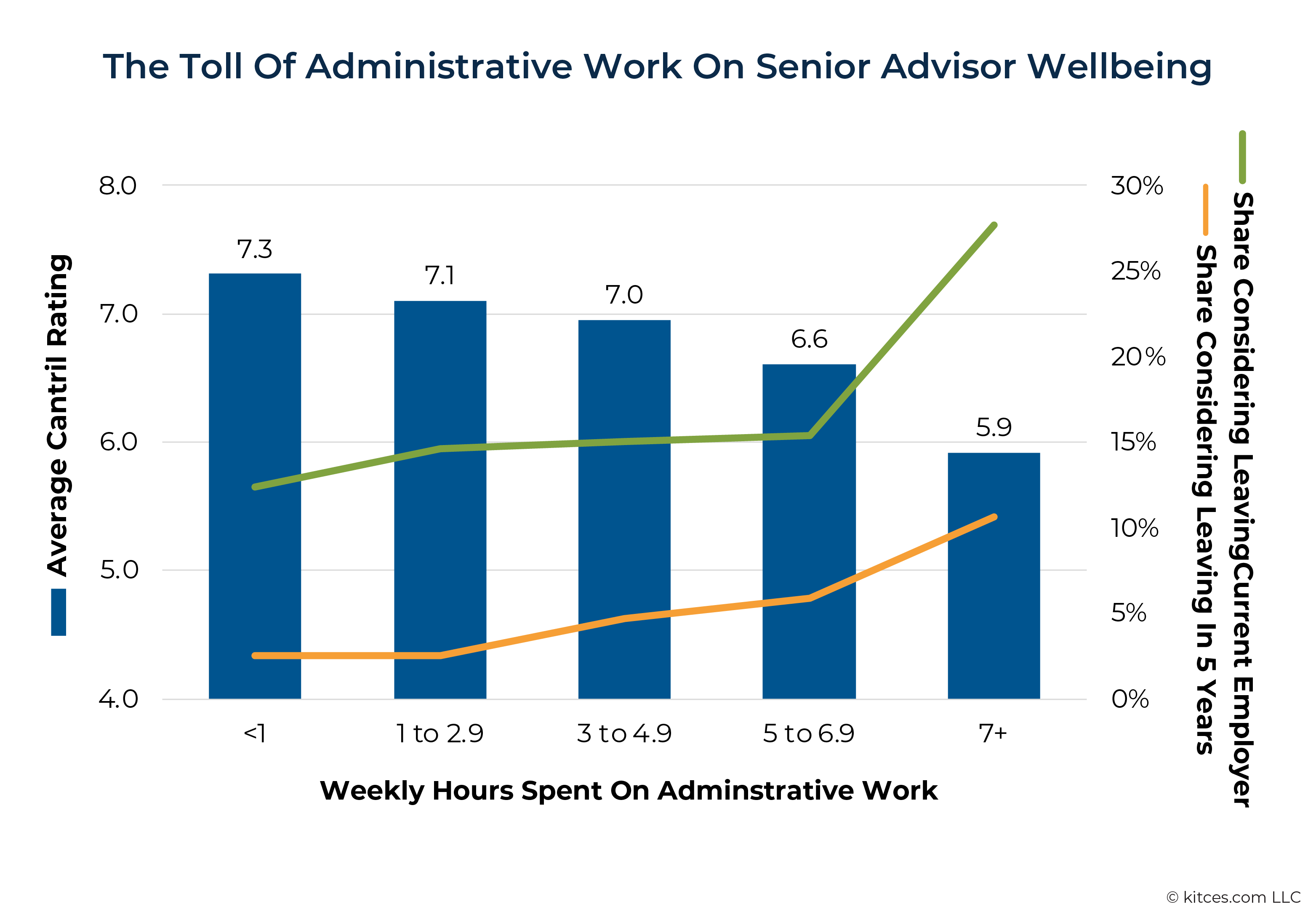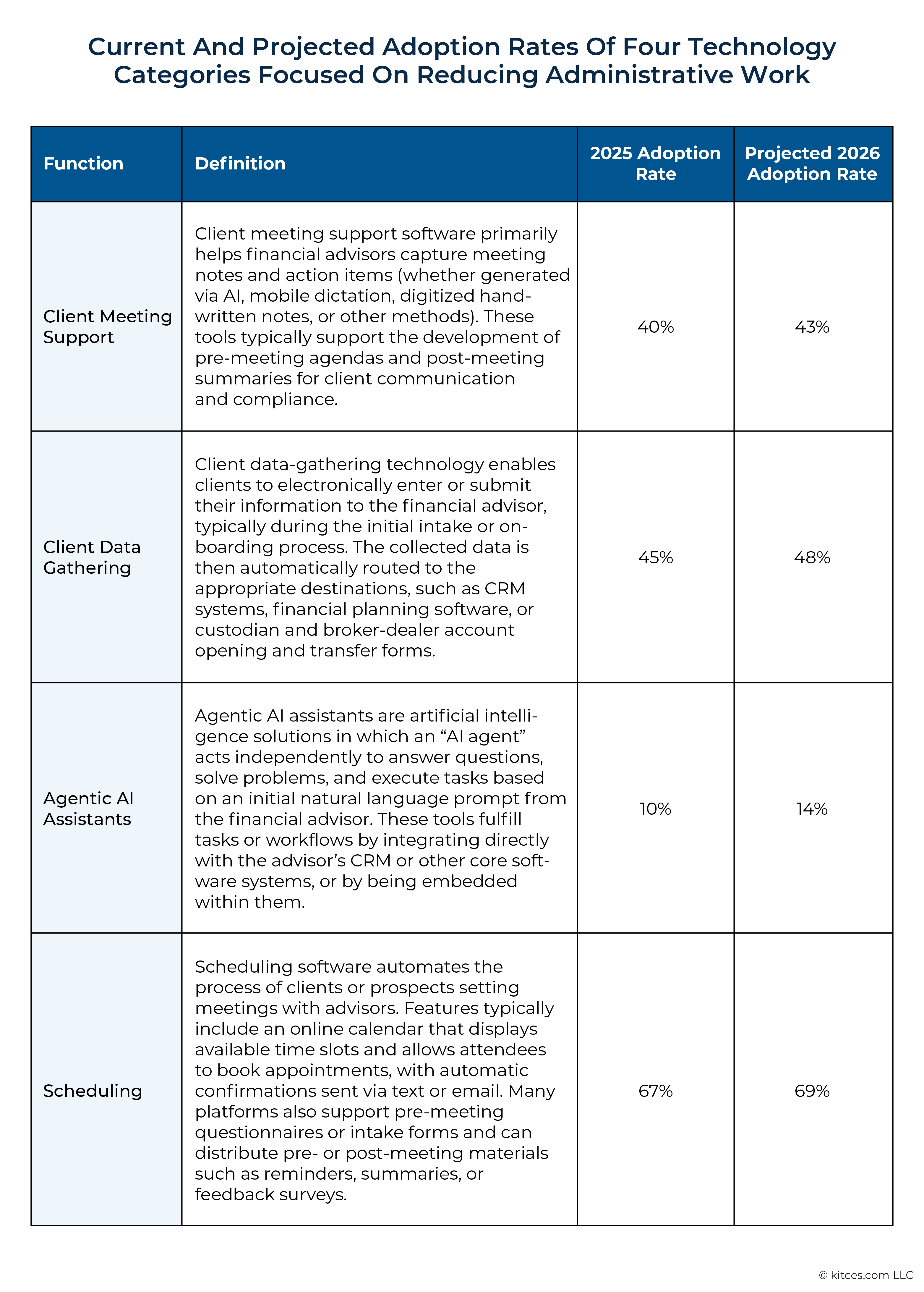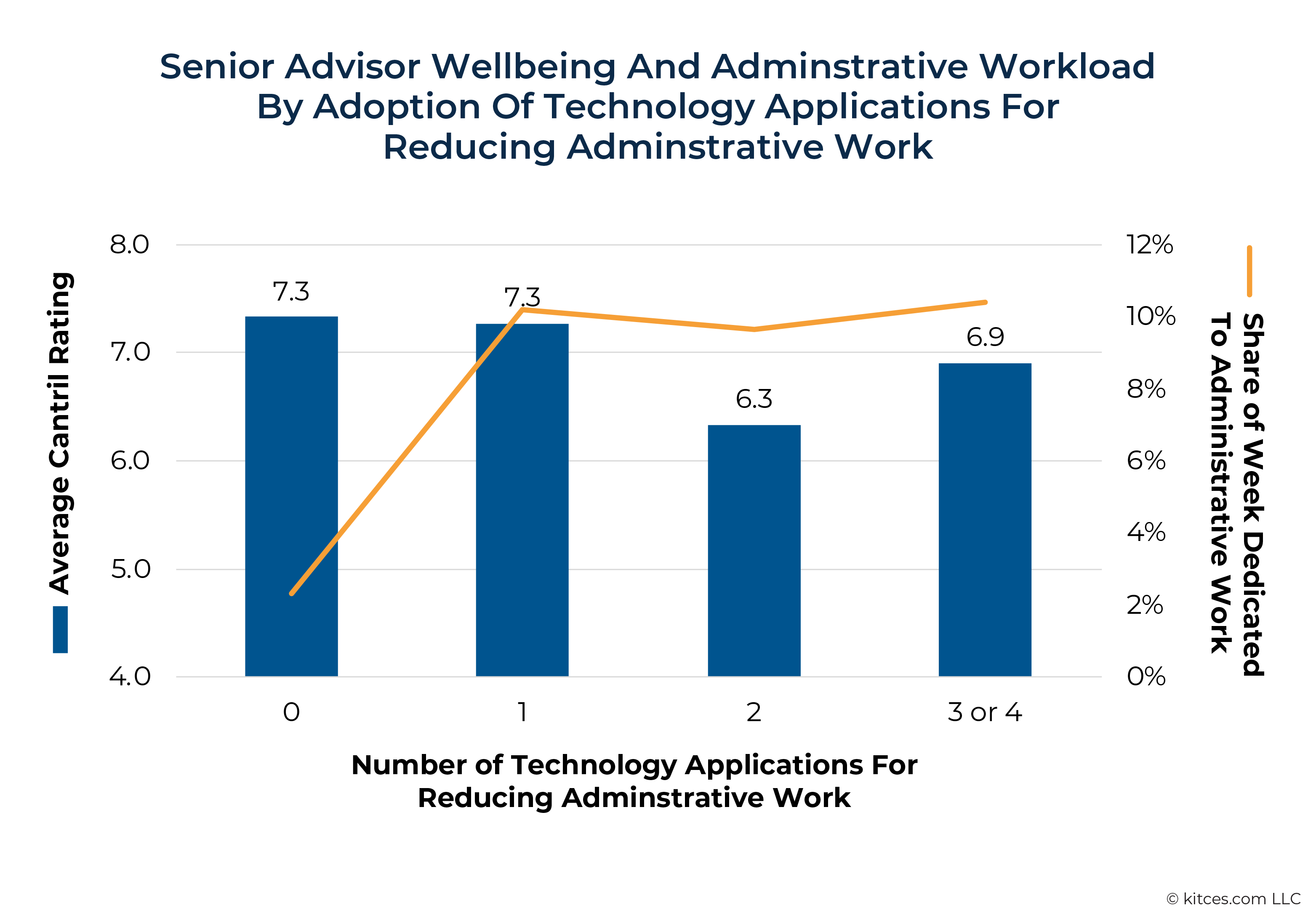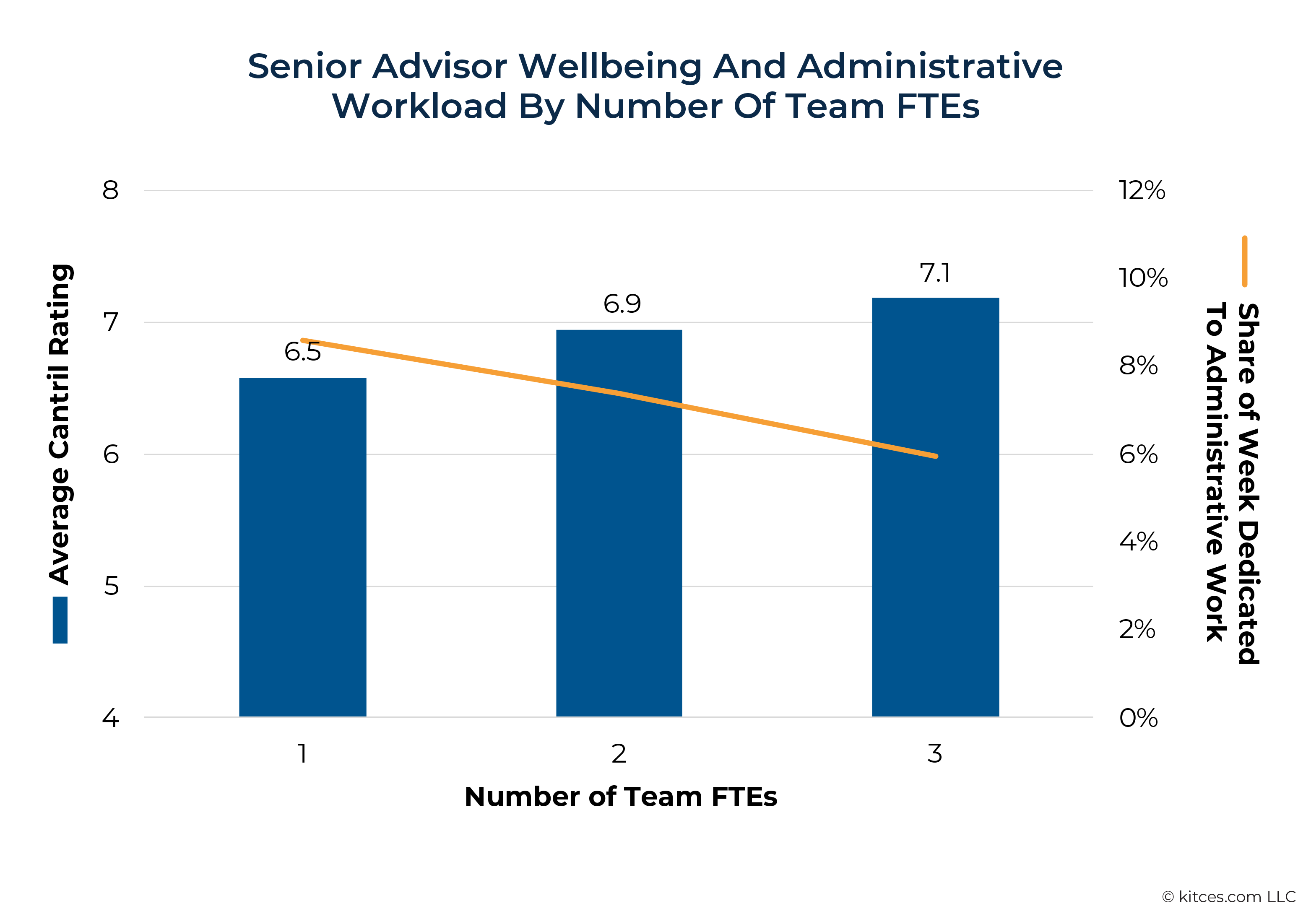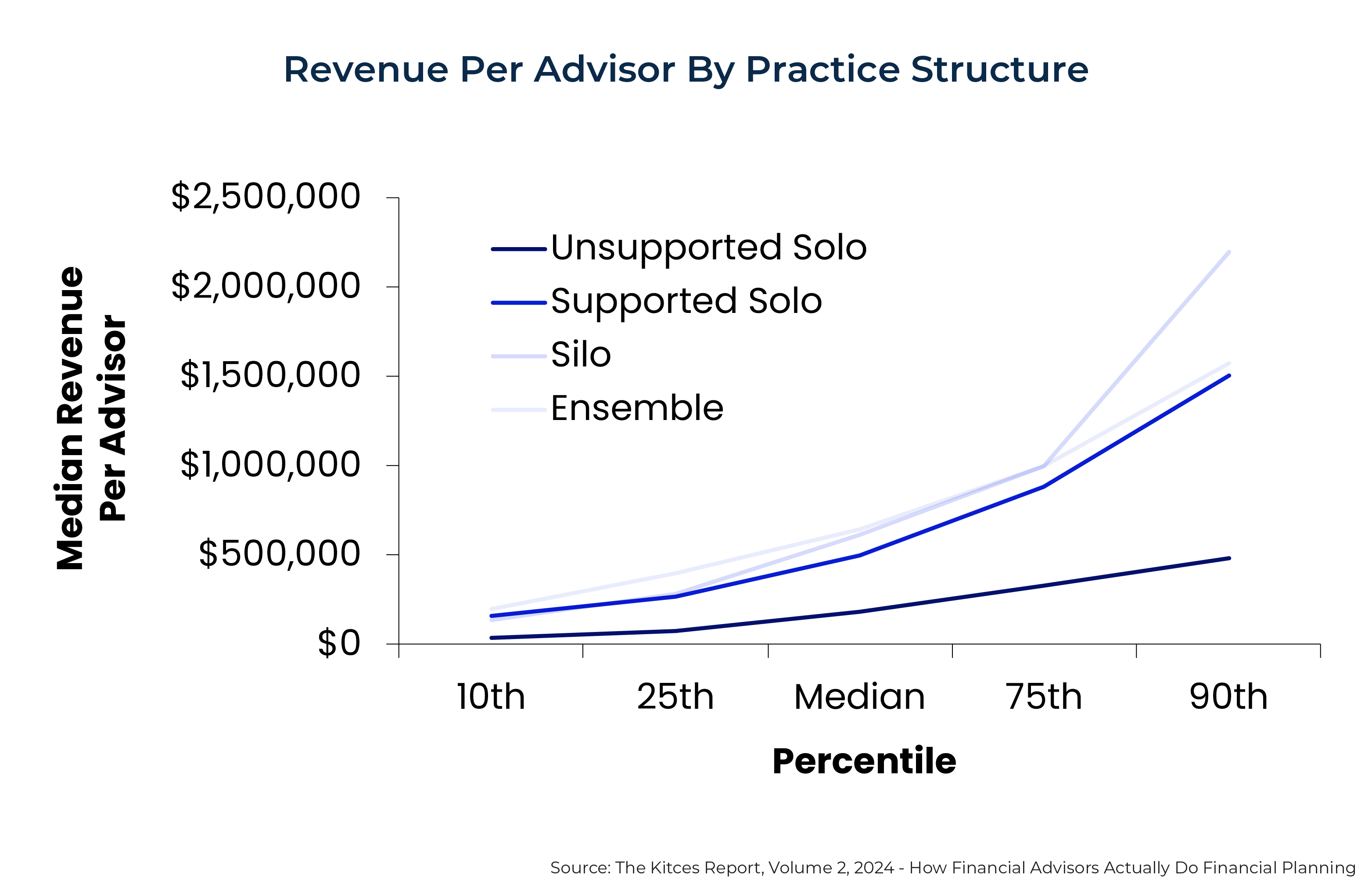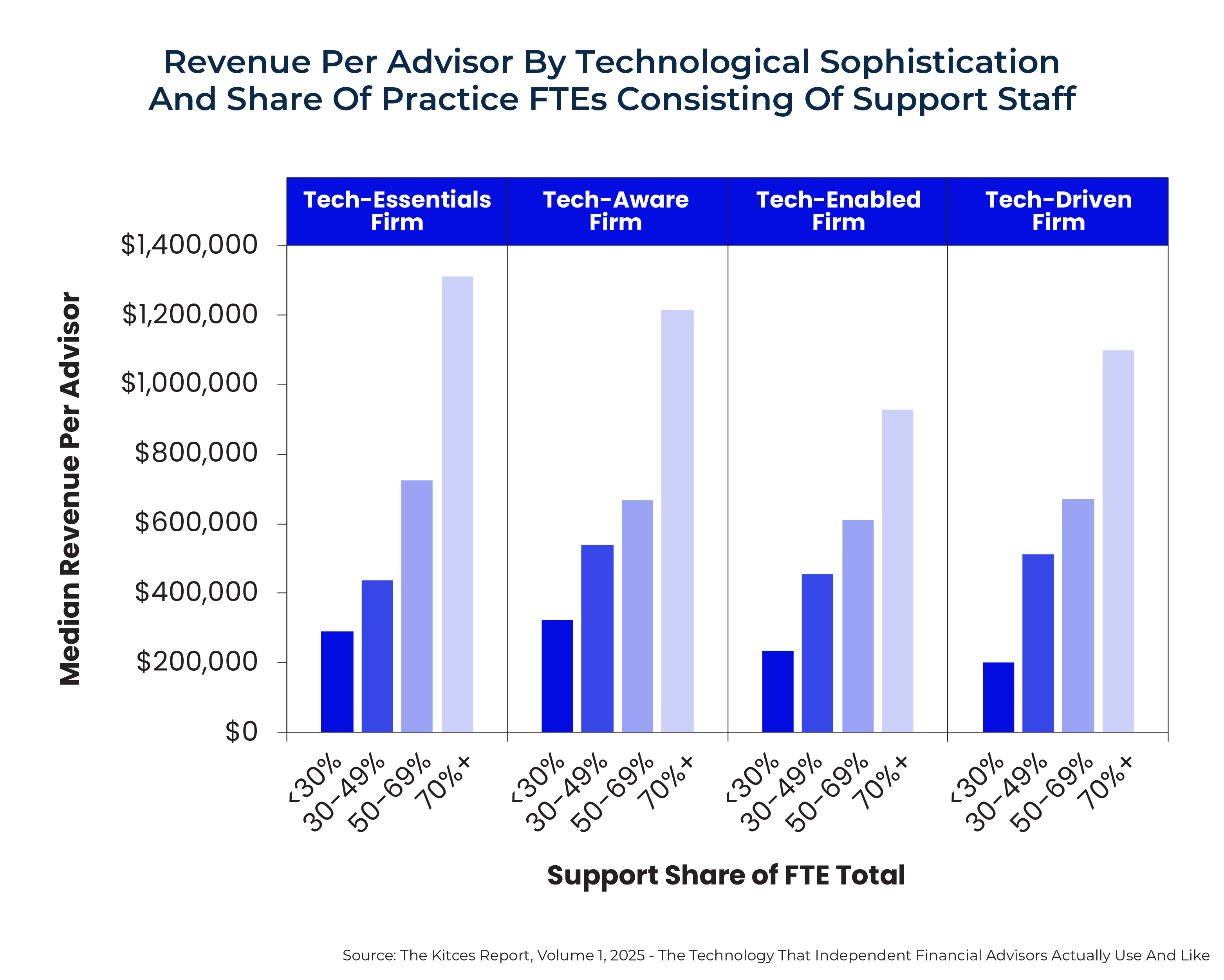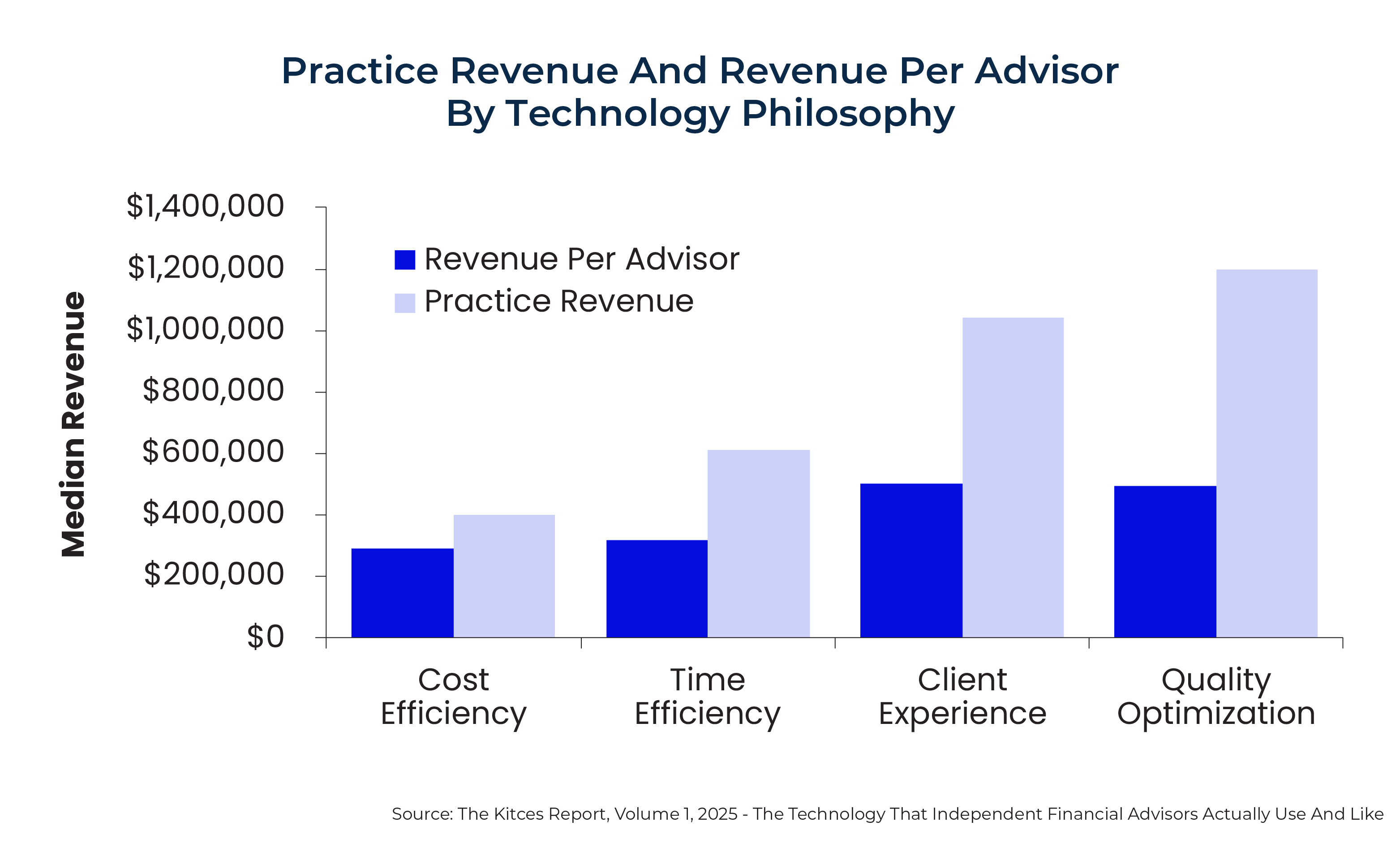Executive Summary
When asking financial advisors about what they love most about their jobs, common answers include the ability to help clients live their best lives, the opportunity to build lasting relationships, and the intellectual challenge of analyzing complex planning problems. One answer that rarely makes the list is administrative work, which not only feels like drudgery in itself but also takes time away from more engaging tasks. Which explains why data from the Kitces Research Study on Advisor Wellbeing show a negative correlation between weekly hours spent on administrative work and wellbeing for Senior Advisors (i.e., those with higher administrative burdens tend to report lower levels of wellbeing).
Two options available to advisors for reducing this administrative burden include investing in technology (e.g., software that can automate or expedite tasks) and/or adding team support (e.g., hiring a Client Service Associate [CSA]). However, given the costs of either solution, advisors will want assurance that such investments actually reduce their administrative load – and ideally contribute to greater wellbeing.
Perhaps counterintuitively, data from our forthcoming Kitces Research on Advisor Technology – shared here as an early preview of the full study – indicate that solo firms investing more heavily in tech tools designed for administrative work do not consistently spend less time on this work or report higher levels of wellbeing. In fact, amongst Senior Advisors surveyed, adopting additional technology applications was actually negatively correlated with wellbeing. Importantly, this isn't a warning against adopting advisor technology tools altogether; rather, Kitces Research suggests that such tools are more effective when used to improve the client experience, allowing advisors to attract and serve higher-value clients that increase the firm's revenue productivity. Put simply, when technology is applied to enhance value rather than just to chase efficiency, greater efficiency often ends up following anyway!
By contrast, the data on adding team support tell a clear and consistent story: advisors with staff to support them spend less time on administrative work and are happier for it. For example, unsupported solo Senior Advisors spend 8.6% of their working hours on administrative tasks. That figure declines to 7.4% with the first support hire (typically a CSA) and further to 5.9% with the second hire (typically an Associate Advisor). In addition to reducing the advisor's administrative burden, these hires also expand capacity to bring on new clients (and the revenue they provide). In fact, Kitces Research data show that while the median unsupported solo advisor generates $182,500 in revenue, supported solo advisors generate more than $500,000! Together, these factors likely contribute to the finding that advisor wellbeing improves with the first hire and sees another boost with the second.
Ultimately, advisors looking to reduce their administrative burden – and improve their wellbeing in the process – are more likely to see greater returns from hiring support staff than from adding efficiency-focused technology. Nevertheless, because certain advisor technology tools can enhance client service (and, in turn, help attract higher-value clients who increase revenue productivity), investments in both areas can pay off for a firm's bottom line – and the advisor's wellbeing!
The Toll Of Administrative Work On Advisor Wellbeing
Asking financial planners about their favorite parts of their job typically yields a range of responses – such as the satisfaction of doing right by their clients, the deep interpersonal connections formed over years of service, the intellectual engagement of planning and portfolio construction, or even the entrepreneurial challenge of building a successful business. Consistently absent from such lists, however, are administrative tasks – like scheduling appointments, completing paperwork, entering data, and managing documents – which are generally seen as necessary burdens that advisors must endure to support the work they truly enjoy.
This sentiment is reflected in advisors' evaluations of how effective they feel at completing various tasks. According to data from our 2023 Kitces Research study on Advisor Wellbeing (shown below), across 13 different business activities, Senior Advisors (i.e., those who manage client relationships and have business development responsibilities) rank their 'bread and butter' tasks of meeting with clients and planning as those in which they feel most effective. By contrast, administrative tasks score second lowest in task effectiveness – ranking just above business development. This area is notoriously challenging for advisors, evidenced by our Kitces Research on Advisor Marketing and forthcoming research on Advisor Technology showing low reported satisfaction with most marketing tactics and the inbound lead generation and outbound prospecting technology applications that attempt (unsuccessfully) to serve these functions.
While advisors generally recognize that administrative work is unavoidable, the actual amount of time they spend on it varies significantly. The typical Senior Advisor dedicates 2.8 hours per week on administrative tasks – approximately 135 hours per year assuming 40-hour workweeks and three weeks of time off – equating to about 7% of their total working hours. Nearly a quarter spend at least five hours each week performing administrative duties, with 7% of advisors dedicating seven or more hours each week to this work!
While this may sound like a relatively small share of time – even the heaviest-burdened advisors (i.e., those spending at least seven hours per week) still devote more than 75% of their time to other tasks – the psychological principle of loss aversion tends to make these hours feel more significant. Loss aversion refers to the idea that individuals feel stronger negative emotions for a loss than positive emotions for a comparable gain. Applied to day-to-day responsibilities, even a relatively small amount of time spent on disliked or draining tasks can feel disproportionately burdensome, simply because we are more sensitive to the things we want to avoid than to the things we enjoy. Which means the 135 hours per year the typical Senior Advisor spends on administrative work – a type of task in which they report feeling less effective than nearly all other areas – can take an outsized personal toll despite representing only a small portion of their total working hours.
This toll becomes apparent when looking at the relationship between advisors' administrative burden and the following three measures of their personal wellbeing:
- Their self-reported levels of personal wellbeing via the Cantril ladder – a survey question in which respondents are asked to think of a ladder, with the best possible life being a 10 and the worst possible life being a 0, and then rate their current lives on the scale of 0–10.
- Their likelihood of leaving their current employer within the next five years.
- Their interest in leaving the financial services industry entirely within the next five years.
Senior Advisors spending less than one hour per week on administrative work average 7.3 on our 0–10 measure of wellbeing (above the average of 6.9). Only 12.4% indicate they're at least "slightly likely" to leave their employer over the next five years, and just 2.5% indicate they may leave the industry entirely.
By contrast, those averaging seven or more hours per week score a 5.9 in wellbeing, with the share considering leaving their current employer more than doubling to 27.7%, and the share considering leaving the industry altogether more than quadrupling to 10.6%! The takeaway is unmistakable: the happiest advisors are those who spend the least time on administrative work, while those with heavier administrative burdens exhibit alarming turnover rates – many of whom ultimately leave the industry entirely.
Two Possibilities For Reducing Administrative Work: Teams Vs Tech
Because administrative work takes a toll on advisors' wellbeing, many advisors look for ways to minimize the time they spend on it. Two options available for advisors to reduce administrative burdens include investing in technology and/or adding team support. While advisors generally look to both technology and team support to lighten the load of administrative work, our research suggests the two options are not equally effective.
Offloading Administrative Work To Technology
One way many advisors do this is to leverage technology. Notably, according to our forthcoming 2025 research report on Advisor Technology, 14% of advisors identify minimizing time spent on administrative work as the single most important use of technology in advisory firms. While this represents a minority of advisors, the fact that a non-trivial share prioritized this option above essential business goals like reducing business expenses or improving value to the client (either by enhancing the quality of advice or the client experience) highlights the urgency that some advisors feel to offload these responsibilities.
Advisors looking to reduce their administrative burden with technology can do so in one of two ways. The first involves automating tasks by eliminating the need for human involvement altogether. For example, integrating custodial platforms and portfolio management systems with client portals can allow statements, tax documents, and performance reports to be automatically deposited in clients' portals each month. This removes the need to manually upload batch reports (or requiring clients to sign into multiple portals to access their documents). Similarly, advisors can establish integrations that allow data to flow automatically across various applications rather than entering it manually.
Alternatively, advisors can expedite tasks by making them more efficient while keeping a human in the loop. An increasingly common example is the use of AI-supported meeting notes tools that transcribe client conversations and integrate directly with CRMs, allowing advisors to review and adjust AI-generated summaries and follow-up tasks before syncing.
While efficiency-enhancing technologies are not new (eSignature tools, for instance, which eliminate the need to mail forms or have clients swing by the office after work, have nearly achieved universal adoption – used by 93% of firms according to our latest data), our forthcoming Kitces Research on Advisor Technology indicates that interest in many such tools is on the rise, four of which are displayed in the table below. Scheduling software remains the most mature of these categories, with the highest adoption and lowest projected growth over the next 12 months. Established generalist tools such as Calendly (the category leader with a 41% market share) have been widely adopted across industries and continue to earn high satisfaction ratings from advisors.

Nerd Note:
To calculate projected adoption rate, Kitces Research asked respondents about their current technology usage across 45 categories and, for those using a tool, whether they planned to make any changes in the next 12 months. If so, they were asked whether they intended to add a new tool, switch to a different one, or discontinue using technology for that function altogether. The results from these questions were used to calculate both current and projected adoption rates both for overall categories and for individual vendors.
Client meeting support tools (which include AI notetakers) and client data-gathering tools are each adopted by a large minority of advisors, with solutions split between generalist providers (e.g., Fathom) and industry-specific solutions (e.g., Jump). Agentic AI assistants, by contrast, are both the least adopted (just 10% of advisors) and the fastest-growing category.
Offloading Administrative Work To Teams
This increased interest in employing technology to streamline administrative functions and improve personal wellbeing raises the question of whether technology is truly the most effective method for doing so. Another possibility is that advisors may actually be better off delegating these tasks to staff rather than automating or expediting them with technology.
The decision of building a tech stack capable of offloading considerable administrative work versus hiring a support staff member is particularly relevant for unsupported solo advisors, who often have the time and resources to invest heavily in only one of the two. According to our forthcoming Kitces Research on Advisor Technology, in 2024, the typical unsupported solo practice generated $175,000 in revenue, paid the advisor $120,000, and spent just under $11,000 annually on the essential technology tools needed to run the firm. Purchasing additional technology tools and investing time to integrate them across the rest of the tech stack still represents a significant commitment of resources—especially since, by definition, the solo advisor is the only one available to do the work. These are resources that can't simultaneously be allocated toward hiring.
Still, this investment in technology amounts to less than the cost of adding a second team member, usually a Client Service Administrator (CSA), which can cost around $70,000 per year (assuming a typical $58,500 salary plus payroll taxes and benefits). Hiring also requires the advisor to manage the recruitment process, onboarding, and ongoing training and oversight – meaning that some of the 'client-related' administrative work delegated away is replaced with 'management-related' administrative work.
Efficiency-Enhancing Technologies Fail To Reliably Reduce Administrative Burdens Or Boost Personal Wellbeing
At least in theory, for solo firms, leveraging technology to offload administrative burdens may at first appear preferable to delegating to a team member for two reasons. The first is that doing so generally results in a lower price tag than adding a seat to the team. The second is that at least some of the client-facing administrative obligations delegated to other team members are offset by new administrative obligations related to hiring and managing others.
Despite this theoretical appeal, however, in practice our data offer no evidence that solo firms investing more heavily in tools designed to reduce administrative work consistently spend less time on these tasks or report higher levels of wellbeing.

Nerd Note:
All calculations displayed are based on data that exclude advisors working at startups, focusing exclusively on those working at established firms. Startups generally have smaller client bases that do not yet generate the same volume of administrative work as more established firms, and they also tend to report distinctively lower levels of wellbeing – either of which could skew the results. Because startups make up a much larger share of solo advisors (16%) than of advisors on multi-member teams (only 3%), excluding them provides a more accurate comparison between solos and teams.
To examine how unsupported solo advisors seek to offload administrative tasks with technology, we looked at their adoption of the four efficiency-enhancing technologies noted earlier (scheduling, client meeting support, client data gathering, and agentic AI assistants). The figure below displays the share of a solo advisor's typical workweek spent on administrative work based on their use of 0, 1, 2, or 3–4 of these tools (with 3 and 4 grouped due to the small sample size of solo advisors using all four). If advisors using more of these tools were successfully reducing their administrative burden, we would expect that to appear in the numbers – which it does not.
Unsupported solo advisors using none of these tools spend the least time on administrative tasks – only 2.3% of their workweek. By contrast, those using 1, 2, or 3+ tools each spend about 10% of their week on administrative work. These groups are otherwise fairly similar: both solo advisors using none of the tools and those using 3 or more have 12–14 years of experience, serve roughly 40 client households, and generate an average of just under $6,500 in annual revenue per client.
This suggests that, while nothing inherently prevents solo firms from using technology to boost efficiency, in practice advisors often struggle to realize the efficiency gains promised by industry vendors. While anecdotes of advisors successfully leveraging technology are easy to find on social media, such success stories are so outnumbered by failures that they fail to register in our data at any statistically detectable level.
Because usage of these tools does not correspond with lower rates of administrative work, it also does not predictably translate into higher levels of wellbeing, as shown in the figure below. In fact, the relationship may even be negative: solo advisors who use none of these efficiency-boosting applications report higher wellbeing than advisors who use 3–4 of them.
Team Support Effectively Reduces Administrative Burdens And Boosts Personal Wellbeing
Our data show that efficiency-enhancing technology does not reliably reduce advisors' administrative burden or improve wellbeing. By contrast, hiring support staff tells a very different story: advisors with team members to lean on spend less time on administrative work and are happier for it.
Unsupported solo Senior Advisors have the highest administrative burden, amounting to 8.6% of their working hours, or nearly 3.5 hours per week, equating to 169 hours per year. This declines to 7.4% of working hours (145 hours per year) with the first support hire (typically a Client Service Administrator), and further to 5.9% (116 hours per year) with the second hire (typically an Associate Advisor).
Which means that the added responsibilities required to manage employees – performance reviews, development plans, workflow management, approvals of timesheets, expenses, and overtime requests – are more than offset by the amount of client-related administrative work that can be delegated to new team members. And because adding seats to the team consistently reduces administrative time for Senior Advisors, it also corresponds with higher levels of personal wellbeing. Solo Senior Advisors score a 6.58 out of 10 on our 0–10 wellbeing measure – below the Senior Advisor mean of 6.91 – while those on two-person teams score a 6.94 and those on three-person teams score 7.18.
Taken together, the data show that delegating administrative work to staff is a far more reliable way for advisors to reduce their administrative load – and improve their overall wellbeing – than relying on technology for the same purpose.
Great Teams Enhance Revenue Productivity
Our recent Kitces Research on Advisor Productivity – as well as our forthcoming Kitces Research on Advisor Technology – shows that the benefits of making a first hire extend far beyond reducing administrative work or improving wellbeing. Adding support staff expands overall revenue capacity, unlocking the potential for the firm to grow. What stands out most in the data is how consistently any team support is better than none – even when that support begins only with a CSA helping a solo advisor. As shown in the figure below, solo advisors with team support more closely resemble the levels of revenue per advisor (or "revenue productivity") found in multi-advisor teams – regardless of whether those firms operate in siloed structures or share profits in ensemble setups – than they do unsupported solos.
The gap between unsupported solo advisors and everybody else is striking. While the median unsupported solo advisor still brings in a solid $182,500 in revenue, that figure is $317,500 (or 64%) less than the $500,000+ median for supported solos. Even at the 75th percentile, unsupported solos generate a respectable $350,000, but that's 61% less than the $900,000 their supported peers are bringing in. Put simply, solo advisors without team support tend to cap out at about a third of the revenue productivity they could reach with the right help in place. In the end, having a team isn't just helpful – it's a prerequisite for running a truly productive practice!
By contrast, investments in technology have a more limited impact on the revenue productivity of service teams. This becomes clear when looking at revenue productivity alongside staff leverage – measured as the share of team members consisting of support staff (i.e., those who support client-facing advisors such as Senior Advisors and Service Advisors, but who do not manage such relationships themselves, like Client Service Administrators or Associate Advisors).
The figure below shows the relationship between staff leverage and revenue productivity, broken out by firms' levels of technological sophistication. Kitces Research defines technological sophistication in terms of three components:
- Incorporation. The breadth of business functions supported by technology.
- Integration. The extent of integration across applications.
- Intentionality. The upfront steps taken to ensure investments in technology are fully realized (e.g., training).
Across the panels running left-to-right – from lower to higher levels of sophistication – the upward slopes of the bars show that staff leverage corresponds with higher revenue productivity no matter the firm's level of technological sophistication. By contrast, the smaller differences when comparing bars of the same color across panels show that technological sophistication matters far less for productivity.
When considering the ability of a team – including CSA support – to drive productivity, alongside the data presented earlier showing that that staff support reduces administrative burden more reliably than technology, it becomes clear why unsupported solo advisors should prioritize expanding their capacity with team members rather than relying solely on tech solutions.
Strategies For Successfully Timing The First Support Hire
Many solo advisors recognize the benefits of building a strong team and, feeling stretched by their client load, may be interested in making their first CSA hire but simply not know where to begin.
Broadly speaking, timing when to make the first hire involves three basic steps:
- Identify a "profitability wall." This is the point where advisors can afford a hire without significantly reducing their own income.
- Identify a "capacity wall." This is the limit where an advisor can no longer take on new clients alone.
- Make the hire between these points. This means having both enough revenue to bring on an employee – typically a CSA – and the mental bandwidth to manage the hiring process.
The exact point will vary by firm, but for most advisors it occurs around 30–40 clients or $200,000–$300,000 in revenue. (Notably, advisors who remain in an "I'll take on any prospect that calls" mode for longer periods often don't hit this threshold until they reach 75–100 clients, as many of those clients only generate $2,000–$3,000 in annual revenue.)
While hiring staff is often the more effective solution for reducing administrative burdens and improving wellbeing, technology continues to shape advisor firms in other important ways – particularly in enhancing the client experience and the quality of advice.
The (Real) Benefit Of Technology For Advisory Firms
Teams clearly reduce administrative burdens, improve wellbeing, and expand productivity more reliably than technology, which raises the question: Why is it still worthwhile to invest in a sophisticated tech stack? While these findings may seem surprising in an industry where vendors often prize technology for its efficiency potential, the disconnect becomes clearer when considering that only 2 in 10 advisors actually view efficiency (reducing administrative burdens or costs) as technology's primary purpose. Instead, the vast majority view of advisors see its most important role as improving value for the client – either by enhancing the quality of advice or elevating the client experience.
From this perspective, the lack of evidence that sophisticated tech stacks correspond with less administrative work or greater revenue productivity isn't a failure – because efficiency was never the main goal for most advisors. In fact, given that advisors' primary aim is to improve value for clients, technological developments over years have resoundingly delivered.
Two decades ago, advisory firms typically operated with 25%–30% profit margins, relying largely on mutual fund sales and limited planning services. Since then, the surge in technology solutions – evident in today's crowded tech landscape (and AdvisorTech Map!) – has transformed both daily operations and the client experience. Clients no longer need to visit the office to sign documents thanks to eSignature capabilities – and in many cases, they don't need to visit the office at all because their relationship with their advisor can be entirely virtual. Financial plans are more personalized and more comprehensive than ever, and client portals now offer advanced performance reporting, account aggregation across multiple institutions, and secure storage for key documents like wills, trusts, and annual tax returns.
However, despite considerable improvements in efficiency, advice quality, and client experience, firms continue to operate within the same 25%–30% profit margins. The reason is clear: Firms that had not previously used technology for key business functions adopted it simply to improve the quality and depth of their services to remain competitive. As a result, the benefits of technological advancements over the past two decades have accrued largely on behalf of clients, who now receive far more value for the same 1% AUM fee, while advisors generate similar profits as before!
Further, our data suggest that technology may best serve firms' bottom line when deployed with a client-centered philosophy (i.e., focused on improving the quality of advice or the client experience) rather than efficiency alone (reducing admin work or costs). Firms taking this approach are not only more productive (in terms of revenue per advisor) but also larger overall (in terms of overall revenue). Put simply, while technology investments may not boost revenue productivity as much as staff leverage, when firms stop using technology to be more efficient and start using it to be better, they can attract and serve higher-value clients – which, in turn, makes firms bigger and more productive!
This article used original data from our 2023 Kitces Research studies on Advisor Wellbeing and Advisor Technology, and also from the forthcoming 2025 Kitces Research study on Advisor Technology. This research – and articles like these – are made possible by advisors who graciously participate in our surveys. Because we repeat each study every two years, we are now gathering data for the upcoming 2025 edition of our Wellbeing study. If you find our original research valuable and are looking for a way to give back, please consider spending 25 minutes completing the survey for our 2025 Advisor Wellbeing study! If you find our original research valuable and are looking for a way to give back, please consider spending 25 minutes completing the survey for our 2025 Advisor Wellbeing study!


